Presentations at Colorado Scientific Society Meetings in 2020
January
Deciphering the timing and causes of Great Unconformity erosion: An example from Pikes Peak, Colorado
Thursday, January 16, 2020
Rebecca Flowers, CU Boulder

Great Unconformity image from: http://strata.geology.wisc.edu/
Abstract: The Great Unconformity (GU) is an iconic geologic feature that marks a major gap in the geological record of the continents, separating Precambrian basement from Phanerozoic sedimentary rocks. Erosion across the GU has been associated with a variety of changes in the Earth System including the Neoproterozoic Snowball Earth, the initiation of modern plate tectonics, oxygenation of the ocean and atmosphere, and the Cambrian Explosion. Much work has focused on Cambrian records unconformably overlying the basement, however, because the GU typically marks a large temporal hiatus in the rock record (commonly 0.5-3 Gyr of missing time), the erosion history leading to its formation cannot be investigated directly by study of preserved sedimentary units. Consequently, the timing and magnitude of erosion below the GU, and whether it was globally synchronous or diachronous, are unknown. Here I present field relationships and new zircon (U-Th)/He data from the 1.07 Ga Pikes Peak batholith in Colorado that constrain the position of the Cryogenian and Cambrian paleosurfaces below the GU. Results provide evidence that most erosion below the GU in Colorado occurred before the Neoproterozoic Snowball Earth and Cambrian Explosion, and thus is unrelated to these events. Ongoing work on the GU in the Grand Canyon and other localities is underway to better constrain the age, duration, and spatial extent of GU formative events and thereby develop a more global understanding of the GU and its significance.
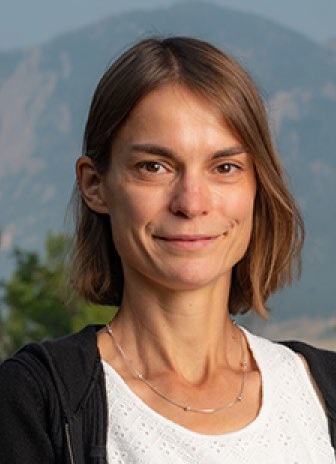
Becky Flowers is an Associate Professor in the Department of Geological Sciences at the University of Colorado – Boulder, where she directs a (U-Th)/He thermochronology lab. She has used thermochronology, geochronology, and geologic observations to address a variety of problems that include deciphering the missing sedimentary record of continental interiors, the topographic evolution of the western U.S. and southern African Plateau, the carving of the Grand Canyon, and the impact history of the moon. Her group’s research also focuses on developing and refining (U-Th)/He thermochronometers. Flowers received her BSc degree at the College of William & Mary in 1998, her MSc degree at the University of Utah in 2000, and her PhD at MIT in 2005. She spent two years as a postdoctoral scholar at Caltech. Flowers is the lead PI and co-director of the AGeS (Awards for Geochronology Student research) program, which is a new strategy for supporting community access to geochronology data and the scientific expertise of lab personnel.
=
February
Postcaldera intrusions associated with the Platoro caldera complex, San Juan Volcanic Locus, Colorado
Thursday, February 20, 2020
Amy Gilmer, US Geological Survey, Denver, CO
Room 241 in Berthoud Hall, Colorado School of Mines, Golden
6:30 pm Social, 7:00 pm Meeting
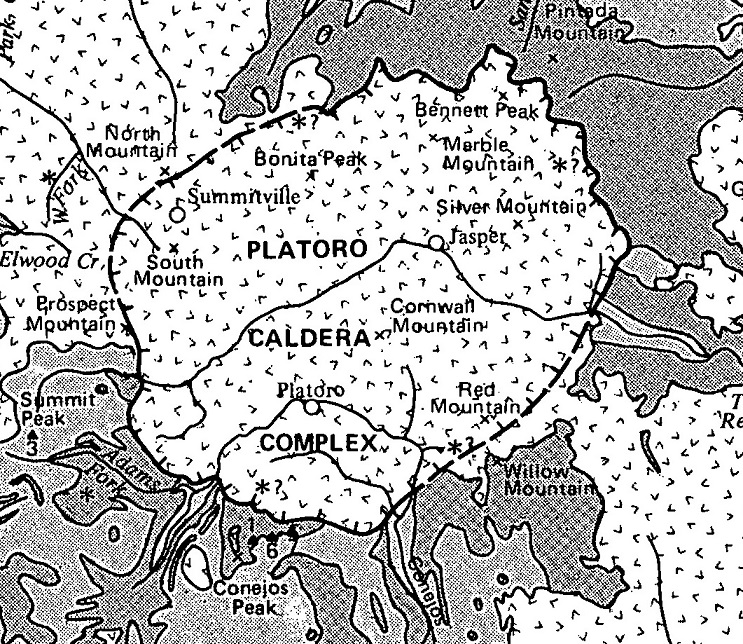
Overview of extent of Platoro caldera complex from: Peter W. Lipman, 1975, Evolution of the Platoro Caldera Complex and Related Volcanic Rocks, Southeastern SanJuan Mountains, Colorado(44 MB), U.S. Geol. Survey Prof. Paper 852, Page 10, Figure 5. (Follow link for paper.)
Abstract: The relationship between ignimbrites and plutonic systems underlying calderas is often difficult to assess because the intrusive rocks are rarely exposed. However, plutonic parts of several Oligocene calderas of the Southern Rocky Mountain Volcanic Field reflect subvolcanic parts of caldera-forming magmatic systems. The Platoro caldera complex in the southeastern San Juan Mountains, erupted up to five large-volume, crystal-rich dacite ignimbrites over 1.5 Ma. Postcaldera magmatism includes andesite to rhyolite volcanics and diorite to quartz monzonite hypabyssal intrusions representing late-stage caldera resurgence or emplacement of volcanic cores adjacent to the caldera. Previous geochronological studies focused on volcanic deposits — ages for intrusions were inferred mainly from cross-cutting relations and stratigraphic position. Exceptional exposures and field relations of both postcaldera volcanic and intrusive rocks enable geochronologic and petrologic assessment of rocks associated with the Platoro caldera in order to track the evolution of that magmatic system from explosive, silicic ignimbrite eruption to intrusion emplacement. New zircon U-Pb SHRIMP dates and zircon trace element data combined with mineral compositions allow us to evaluate whether plutons in the Platoro system are the unerupted remains of a shallow post-ignimbrite magma reservoir or the result of subsequent emplacement of magma from other parts of the system. Resulting dates span too much time (>> 1 Ma) to represent magma evolution in a single upper crustal chamber and require remobilization of mush from different depths in the trans-crustal magmatic system.
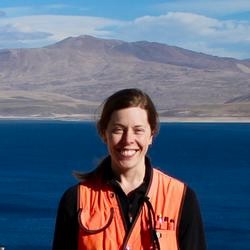
Amy Gilmer is a research geologist with the Geosciences and Environmental Change Science Center of the USGS in Denver, CO. She studies the role of magmatic and hydrothermal processes in volcanic belts and is currently investigating ignimbrites and intrusions of the San Juan magma reservoir, Rio Grande extension-related magmatism, and ore deposition along the Intermountain West Transect. Amy has also worked on igneous complexes associated with porphyry copper systems in the Andean Cordillera of Chile. Amy received her BSc degree at the College of William & Mary in 1999, her MSc degree at The University of Texas at Austin in 2001, and her PhD at the University of Bristol in 2016. Amy also worked for the Virginia Division of Geology and Mineral Resources conducting mineral resource assessments and geologic mapping in the Virginia Blue Ridge, Piedmont, and Coastal Plain.
Because of the COVID-19, aka. novel corona virus, pandemic, we were unable to continue having in-person meetings in the spring of 2020.
The following meetings were held virtually using Zoom. Links to the Zoom recordings of these meetings follow the Abstract and speakers’ Biographies.
=
July
Historic Avalanches in Hinsdale County, Colorado: Impacts to Lake City, old mining dams, and new evidence for the association of snow-and-rock avalanches as a means of forming rock glaciers
Thursday, July 16, 2020
Jonathan Lovekin, Colorado Geological Survey, Golden, CO
The link to the recording of the Zoom presentation is posted below, after the Abstract and Speaker Bio.
Abstract: During late winter of 2019, Hinsdale County (and other areas of Colorado) experienced unprecedented avalanche activity. Hundreds of avalanches were of a size and destructive power beyond anything previously recorded in Colorado. Most of the avalanches ran along established paths but were wider and longer than previous events. Some occurred in areas without previous activity, carving through mature timber, shaving trees and soil down to bedrock, and forming impact features either high up opposite sides of valleys or comingled with avalanches originating from the other side. In 2019, avalanches filled both Henson Creek and the Lake Fork of the Gunnison River above Lake City, CO, with debris fields consisting of a morass of trees, soil, and rock packed in snow and ice. Henson Creek also contains two historic, concrete dams constructed in the 1880’s and early 1900’s (the Ute-Ulay and Hidden Treasure dams). The potential for catastrophic flooding and/or debris flows into Lake City led Governor Jared Polis to issue three emergency declarations. Analysis of the dams and the potential impacts from debris led to the partial removal of the Hidden Treasure dam. Evaluation of the natural draining characteristics of the debris/ice mixtures concluded that construction of debris-flow barriers was not necessary. At least one snow avalanche was comingled with a massive rock avalanche. That case demonstrates a clear link between snow and rock avalanches and provides evidence for a potential mechanism in the formation of high-mountain rock glaciers.
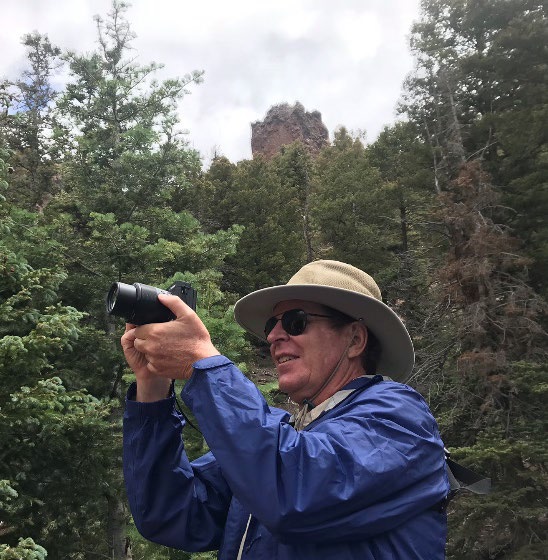
Jonathan Lovekin is an engineering geologist with the Colorado Geological Survey in Golden, Colorado, specializing in geologic hazards and their potential impacts to planned development. He provides technical input on projects in geologically difficult terrain and responds to requests from the Colorado Office of Emergency Management or local governments for specific hazards that may impact public safety. He provides technical assistance and presentations about risks related to rockfall, landslides, debris flows, accelerated erosion, avalanches, and post-wildfire geologic threats. Jon received a BA in Geology from the University of Colorado in 1982 and a Master of Engineering (Geological Engineer) from the Colorado School of Mines in 2007. He also has experience interpreting stratigraphy and sedimentology in oil and gas exploration, assessing environmental problems related to historic mining, and evaluating geologic hazards related to urban development projects. He has been a rockfall mitigation specialist on projects in the San Juan Mountains and throughout the United States.
Flyer about: Colorado Scientific Society Lecture, Historic Avalanches in Hinsdale County, July-2020 by Jonathan Lovekin
Link to see a video of CSS July, 2020 Presentation by Jonathan Lovekin

Click on the video to play it with your video player. You do not need to sign-in.
Duration: 1:05:05
DISCLAIMER & FAIR USE STATEMENT: This CSS meeting recording contains content that expresses the opinions, viewpoints, and conclusions of the speakers and does not necessarily reflect the views, policies, or endorsements of the Colorado Scientific Society. This recording is made available to the public for general information and educational purposes only and is not intended to be used for profit. Any use of copyrighted material included therein for other purposes must obtain express written permission from the author.
=
August
Water & Energy in Colorado:
Emulsifying Two Great Challenges in Four Parts
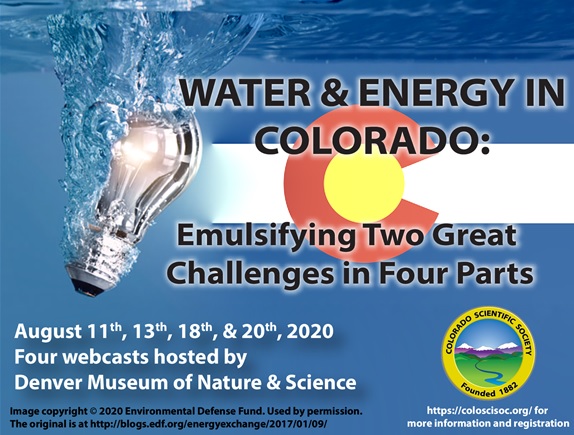
The four sessions focused on the following topics:
- Part I: Resource Providers
- Part II: User Community Perspectives
- Part III: Technology Addressing Current Challenges
- Part IV: Future Pathways
Go to the Symposium on Water and Energy in Colorado page for full details and links to video recordings of the sessions on YouTube.
=
September
CSS Past Presidents’ Presentation
Rise of the Mammals: Exceptional Continental Record of Biotic Recovery after the Cretaceous–Paleogene Mass Extinction
Thursday, September 10, 2020, Online event
Tyler Lyson and Ian Miller, Denver Museum of Nature and Science
The link to the recording of the Zoom presentation is posted below, after the Abstract and Speaker Bios.
Eoconodon Coryphaeus, first appeared 680,000 years after the Cretaceous-Paleogene mass extinction. It was about the size of a wolf. See the DMNS website for more details.
Learn about their discoveries at Corral Bluffs, east of Colorado Springs, seen on the Nova episode Rise of the Mammals on PBS.

Abstract: In 2016, a team from the Denver Museum of Nature & Science (DMNS) led by Drs. Tyler Lyson and Ian Miller made an extraordinary discovery of fossils in rocks that date to immediately after the Mesozoic Era, just to the east of Colorado Springs, CO. These fossils reveal in striking detail how the world and life recovered after the catastrophic asteroid impact that wiped out the dinosaurs 66 million years ago. The unprecedented find described in the Nov. 2019 issue of Science Magazine includes thousands of exceptionally preserved animal and plant fossils from the critical first million years after the catastrophe and shines a revelatory light on how life emerged from Earth’s darkest hour. The fossil-bearing outcrops in the Denver Basin add powerful evidence to the idea that the recovery and evolution of plants and animals were intricately linked. Combining a remarkable fossil plant record with the discovery of the fossil mammals has allowed the team to link millennia-long warming spells to global events, including massive amounts of volcanism on the Indian subcontinent. These events may have shaped the ecosystems half a world away.
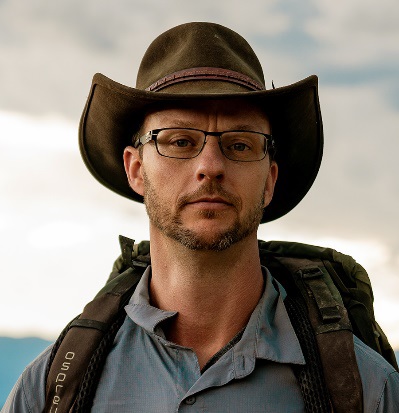
Tyler Lyson is a vertebrate paleontologist who studies the extinction of dinosaurs, the rise of mammals, and the evolution of reptiles, particularly turtles. He has conducted fieldwork throughout the American West and has active field sites in North Dakota, Montana, and Colorado. Born in North Dakota, Tyler has been doing paleontology fieldwork since he was in middle school. He received his BA from Swarthmore College in 2006 and his PhD from Yale University in 2012. He completed a postdoc at the Smithsonian Institution before joining the DMNS in 2016 as Associate Curator of Vertebrate Paleontology.
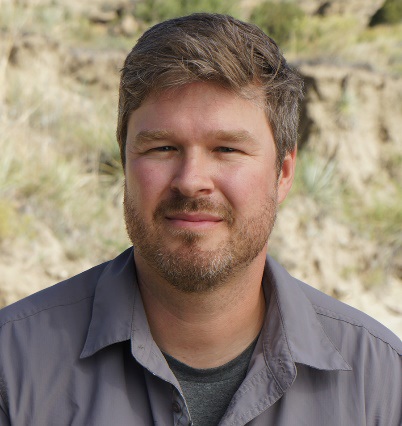
Ian Miller is a paleobotanist whose primary interests are fossil leaves and the ways they inform us of ancient ecosystems and climate. Ian discovered geology and paleontology while scavenging mine tailings for fool’s gold and pulling Miocene clams out of road cuts as a youth in Washington State. He attended The Colorado College and did his first paleobotanical work at the DMNS as a hopeful intern. After two years as a field geologist in New Mexico, Ian went to Yale University where he studied paleobotany and tectonics and earned a PhD in 2007. Ian returned to Denver and the Museum in 2006 where he is now Associate Curator of Paleobotany.
For more about their discovery, see:
PBS Nova video: Rise of the Mammals
DMNS Exhibit: After the Asteroid: Earth’s Comeback story
DMNS website: https://coloradosprings.dmns.org/ – Has interactive 3-D displays of early Paleogene mammal skulls, short videos, podcasts, and more.
Flyer about CSS Lecture, Rise of the Mammals, Sept. 10, 2020, by Ian Miller and Tyler Lyson.
View Tyler Lyson and Ian Miller’s presentation to the CSS by clicking on this link:

Click on the video to play it with your video player. You do not need to sign-in.
Duration: 1:20:51
DISCLAIMER & FAIR USE STATEMENT: This CSS meeting recording contains content that expresses the opinions, viewpoints, and conclusions of the speakers and does not necessarily reflect the views, policies, or endorsements of the Colorado Scientific Society. This recording is made available to the public for general information and educational purposes only and is not intended to be used for profit. Any use of copyrighted material included therein for other purposes must obtain express written permission from the author.
The CSS Fall 2020 Field Trip to Corral Bluffs walked through the first million years after the K/Pg extinction. Corral Bluffs’ record of both animal and plant fossils describes successive environments, as more complex plants provide food sources for larger and more diverse animals.
=
October
CSS Emmons Lecture
21st Century Field Geology on the New Frontier
Thursday, October 8, 2020, Online event
Dr. Michael Zolensky, Planetary Scientist, Astromaterials Research & Exploration Science, NASA Johnson Space Center, Houston, TX
The link to the recording of the Zoom presentation is posted below, after the Abstract and Speaker Bio.

Abstract: Samuel Franklin Emmons’ life was dedicated to geological field studies, and the exploration of Colorado and the rest of the American west. We are now living through the golden age of the geological exploration of the Solar System. Just as the 19th century geological survey exploration parties would send runners out to nearby mountains to retrieve a few hopefully representative rocks for examination, the space-faring nations are now sending out robotic “runners” to return rocks from asteroids, a comet, the moons of Mars and ultimately the other terrestrial planets. This talk will focus on the current missions to retrieve samples from two primitive asteroids and the largest moon of Mars. The first of these spacecraft, Hayabusa2, will arrive back on Earth just two months from this lecture.
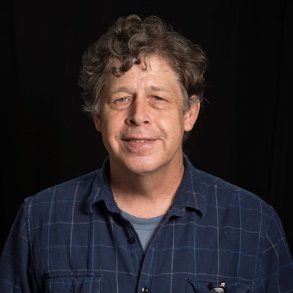
Michael Zolensky works on the characterization of the chemical weathering record of asteroids and primitive mineralogy of comets. He is currently leading efforts to locate and characterize aqueous fluid inclusions in astromaterials. He has played critical roles in successful meteorite recovery expeditions on four continents and developed techniques for characterization of meteoroid and space debris impact features on spacecraft. Dr. Zolensky has also led the effort to characterize the impact record of the Long Duration Exposure Facility (LDEF) satellite and developed new techniques for analysis of microparticles. He led sample analysis teams for the Stardust comet dust return mission, and the Hayabusa asteroid regolith sample return mission. Now he is on the science teams of the Hayabusa2 and Mars Moons Exploration missions, which are developing the next generation of astromaterial sample handling and analysis protocols.
Mike received his Bachelor’s of Science degree in Geology from the New Mexico Institute of Mining and Technology in 1977 and his Ph.D. degree in Geochemistry and Mineralogy from the Pennsylvania State University in 1983.
https://ares.jsc.nasa.gov/people/bios/michael-e-zolensky/
CSS Emmons Lecture, Oct. 8, 2020, Field Geology on the New Frontier by Mike Zolensky, announcement for posting
View Michael Zolensky’s presentation to the CSS by clicking on this link:
Click on video to play it with your video player. You do not need to sign-in.
Duration: 1:28:21
DISCLAIMER & FAIR USE STATEMENT: This Zoom-meeting recording contains content that expresses the opinions, viewpoints, and conclusions of the speakers and does not necessarily reflect the views, policies, or endorsements of the Colorado Scientific Society. This recording is made available to the public for general information and educational purposes only and is not intended to be used for profit. Any use of copyrighted material included therein for other purposes must obtain express written permission from the author.
=
November
The Rock that cried silver tears – The Early Jurassic Springdale Sandstone and its unusual precious metal mineralization at Silver Reef, UT, revisited
Thursday, November 19, 2020, 7:00 pm, Online event
Uwe Kackstaetter, Ph.D., Metropolitan State University
The link to the recording of the Zoom presentation is posted below, after the Abstract and Speaker Bio.
Abstract: The Early Jurassic Springdale Sandstone Member of the Moenave Formation at Leeds, UT, is one of the most unusual precious metal deposits in the world. Void of any recognizable hydrothermal activity, this sheet‐like, 30 m thick, fluvial sandstone contains the rare minerals cerargyrite (AgCl; Horn Silver), bromargyrite (AgBr), and iodargyrite (AgI) in mineable quantities. Because mineralization is finely disseminated in an otherwise unaltered sedimentary rock, it was initially considered a hoax following its discovery in 1866. However, the Silver Reef mining district produced over 7 million ounces of Ag between 1875 to 1909 at a value close to $8,000,000. Later, the same rocks were mined for uranium during the cold war period.
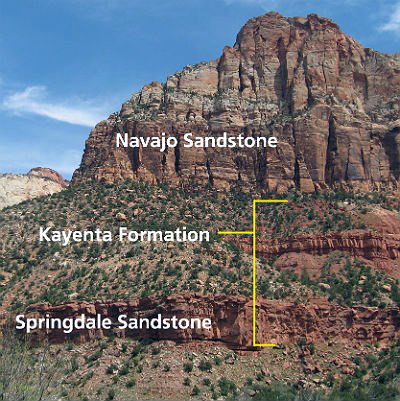

The first scientific investigation of the deposit was completed in 1953 by the late Paul Dean Proctor. Subsequent studies yielded multiple hypothesis for the unusual ore mineralization, but no compelling genetic model. Since then, sophisticated instrumentation, such as portable X‐ray fluorescent (XRF) spectroscopy and scanning electron microscopy (SEM) with in‐situ EDS microanalysis, have created novel possibilities for geochemical reevaluation. Mineralization in the Springdale Sandstone has been revisited through a series of undergraduate research projects at the Department of Earth & Atmospheric Sciences at Metropolitan State University of Denver. This presentation will pay homage to Paul D. Proctor’s work while introducing the audience to some of the exciting undergraduate research projects on this most unusual deposit.
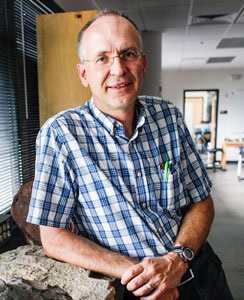
Dr. Uwe Richard Kackstaetter received his B.A. in Geology from the University of Northern Colorado, his M.S. in Geology from BYU, Provo and his Ph.D. in Applied Geology and Mineralogy from the University of Würzburg, Germany. His professional expertise on two continents ranges from environmental testing and geohydrologic investigations to minerals and igneous petrology. He has taught earth science at college and secondary levels and lead national and international geological field courses. Dr. Kackstaetter’s current interests are applying advanced tools to geoscience problems, including field specific‐gravity testing, automated percolation testers, wavelength‐dependent night prospecting tools, improved processes of rock and mineral thin sectioning, field portable cation chromatography and clay‐mineral analytical processing and computations. He currently works as Full Professor of Geology at Metropolitan State University of Denver where he is an advocate for undergraduate research that involves students in meaningful geoscience studies in both in Europe and the United States.
CSS Lecture, Nov. 19, 2020, Springdale Sandstone and Silver Reef, Utah, by Dr. Uwe Kackstaetter, announcement for posting.
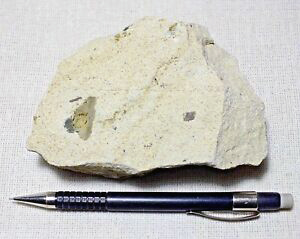
View Uwe Kackstaetter’s presentation to the CSS by clicking on this link:

Click on video to play it with your video player. You do not need to sign-in.
Duration: 1:14:26
DISCLAIMER & FAIR USE STATEMENT: This Zoom-meeting recording contains content that expresses the opinions, viewpoints, and conclusions of the speakers and does not necessarily reflect the views, policies, or endorsements of the Colorado Scientific Society. This recording is made available to the public for general information and educational purposes only and is not intended to be used for profit. Any use of copyrighted material included therein for other purposes must obtain express written permission from the author.
=
December
CSS Annual Presidential Address
Pleistocene water-table fluctuations in Black Hills aquifers linked to subglacial recharge in southern Canada?
Evidence from speleothems in Wind Cave National Park
Thursday, December 17, 2020
Dr. James B. Paces, United States Geological Survey
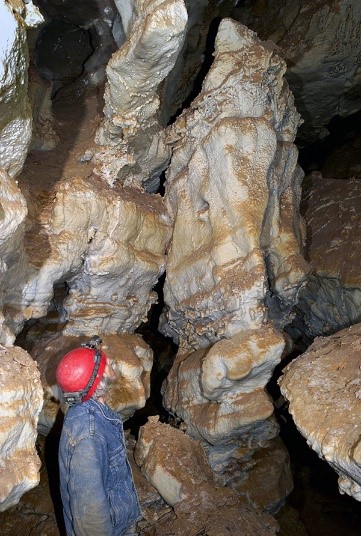
The link to the recording of the Zoom presentation is posted below, after the Abstract and Speaker Bio.
Abstract: Phreatic speleothems in the lower levels of Wind Cave preserve a 300-ka paleohydrologic record of water-table fluctuations along the east flank of the Black Hills in South Dakota. U-series dating of wall coatings and foundered cave rafts indicate that maximum paleo water-table high-stands were less than 45 m and more typically less than 25 m above the modern potentiometric-surface. Periods of non-deposition are interpreted as subaerial conditions that, in some cases, include evidence for vadose flow. Ages of basal layers indicate that subaerial conditions existed between ~1,000,000 and 300,000 years. After that, water-level high stands correlate to interglacial/interstadial periods and low stands correlate to full glacial or stadial periods. Isotopic compositions of δ18O, 87Sr/86Sr, and 234U/238U in speleothems younger than 12 ka are consistent with compositions of modern groundwater in the cave. However, older calcite has δ18O, 234U/238U, and 87Sr/86Sr values similar to modern regional groundwater, suggesting that groundwater during high-stands was more like present-day artesian sources having warmer, deeper flow paths rather than shallower, cooler sources associated with local recharge.

Data do not support previous interpretations of a monotonic water-table decline caused by local hydraulic changes. Instead, low stands are interpreted to reflect cold, dry conditions that provided little local recharge to shallow aquifers. High stands likely reflect reorganization of regional flow systems caused by subglacial recharge into the Madison aquifer beneath the Laurentide ice sheet on the northeast side of the Williston Basin (Grasby et al., 2000, Geology 28). Increased hydraulic pressure in a confined aquifer is capable of causing reversed flow into the basin with water-level increases on its south flanks as long as hydraulic connectivity is maintained. Subglacial recharge resulting in overpressuring within the confined Madison aquifer is considered the most likely driving force for increased heads within Paleozoic aquifers of the Black Hills, even though the timing of ice sheet advance and Wind Cave high stands were not synchronous.
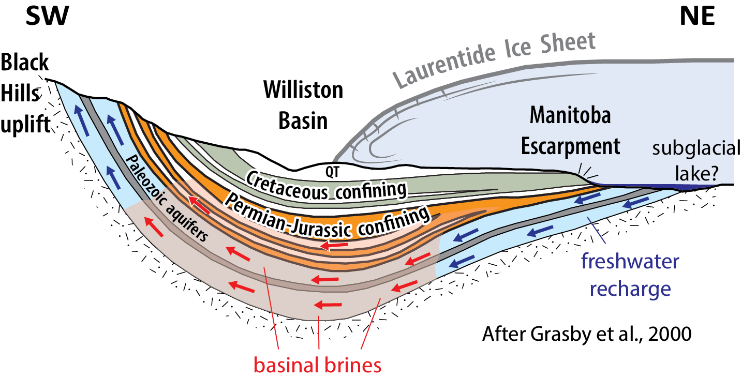
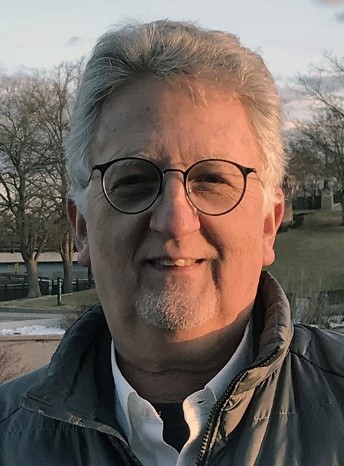
James Paces is a research geologist at the U.S. Geological Survey in Denver, CO. He has used radiogenic isotopes to study a wide variety of earth processes including generation and emplacement of Midcontinent Rift magmas; age and origins of Apollo 17 mare basalts; paleohydrology of the potential nuclear-waste repository at Yucca Mountain, NV; identification of hydrologic sources and mixing in arid wetlands; dating of early hominin sites in North America; and studies of karst evolution in several National Parks. Paces received his Bachelor of Science degree in geology from the University of Oregon in 1978, and his Ph.D. in geology from Michigan Technological University in 1988
CSS Lecture, Dec. 17, 2020, Black Hills aquifers in Wind Cave linked to subglacial recharge from Canada by speleothems in Wind Cave, by Dr. James Paces, announcement for posting.
View James Paces’ presentation to the CSS by clicking on this link:

Click on video to play it with your video player. You do not need to sign-in.
Duration: 1:39:50
DISCLAIMER & FAIR USE STATEMENT: This Zoom-meeting recording contains content that expresses the opinions, viewpoints, and conclusions of the speakers and does not necessarily reflect the views, policies, or endorsements of the Colorado Scientific Society. This recording is made available to the public for general information and educational purposes only and is not intended to be used for profit. Any use of copyrighted material included therein for other purposes must obtain express written permission from the author.



